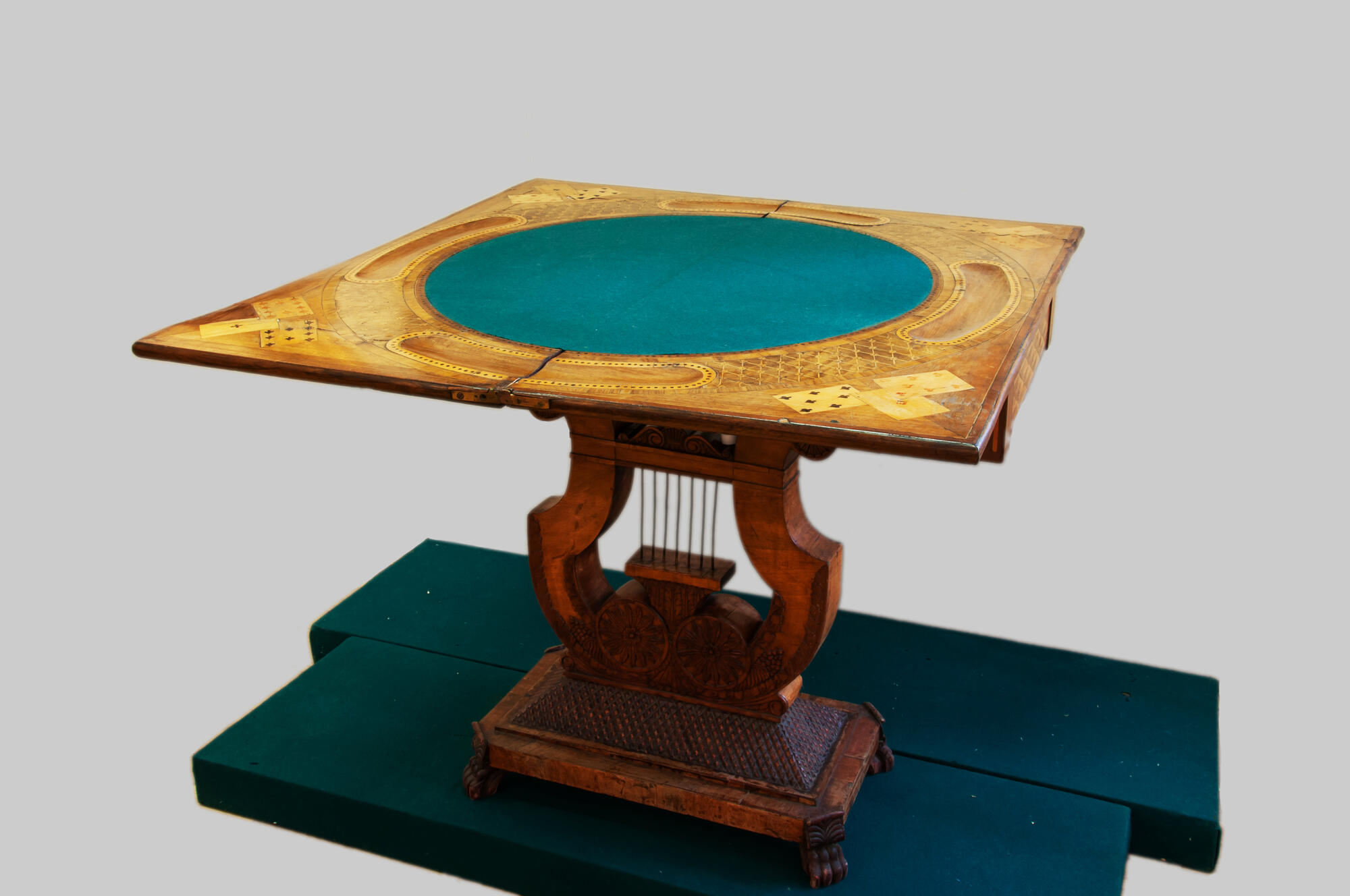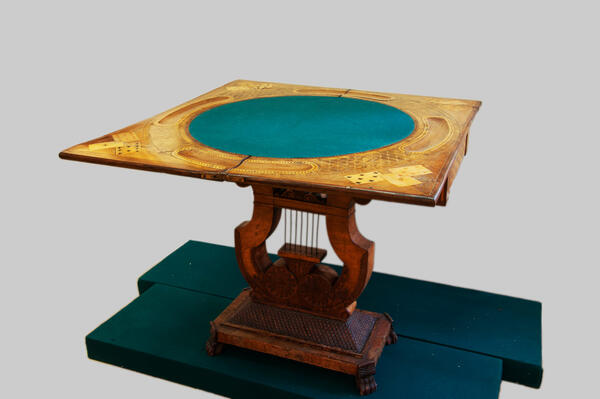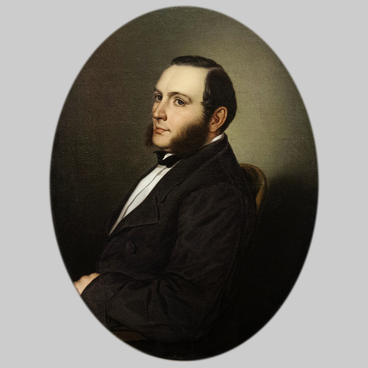A table for playing cards. In Russia, this kind of table is known as the lomber table, owing its name to the card game ‘ombre’ (from Spanish hombre, meaning ‘man’). In a game of ombre, one person (the ‘man’) plays against a team of two, three, or more opponents. This game originated in Spanish aristocratic circles in the 14th century, before spreading throughout Europe. In Russia, this game was in fashion between the second half of the 18th and the early 19th century. The ombre was the only game to be spared by the ban on ‘gambling of any kind’ that was imposed by Catherine the Great at the very beginning of her reign.
This card table has a foldable tabletop. When folded, it looks like a regular coffee or dining table. During games, the table was unfolded, exposing its inner side. The exhibit on display is set up precisely in such a ‘game position.’
In its unfolded state, the board has a square shape, with special grooves for chalk on all four sides (chalk was used for making notes on the tablecloth). The corners are decorated with mosaic images of playing cards. When folded, the board is decorated with a mosaic rhombus pattern.
Card tables were an essential interior element of Russian residences. They were made of mahogany or local wood species painted to look like mahogany.
This table belonged to the Talyzin family from the Denezhnikovo estate situated in the Bronnitsy District.
Based on the known documents, the Talyzin family tree dates back to the 15th century. The names of its members are found in accounts of many significant events in the history of the Russian state.
The estate ensemble of Denezhnikovo was built by a member of the Admiralty Board since 1748, admiral Ivan Lukyanovich Talyzin (1700–1779). Ivan Lukyanovich was a relative of Nikita Ivanovich Panin, a diplomat in charge of the Russian foreign policy. Another relative of Ivan Talyzin was the Chancellor of the Russian Empire Alexey Petrovich Bestuzhev-Ryumin.
It was he who famously replied to the envoys of Peter III that they should ‘leave the way they came, for he had not seen any Emperor of Russia, and serves faithfully only to the sole Empress of All Russia, Catherine II.’
Eventually, Denezhnikovo passed on to Ivan Lukyanovich’s male heir, Alexander Fyodorovich Talyzin (1731–1787).
Alexander Talyzin played a prominent role in the plot to overthrow Peter III and crown Catherine the Great. The Empress entered Petersburg disguised in Talyzin’s uniform. This uniform was kept as an heirloom by the Apraksin family first in the village of Olgovo in the Moscow Province, and then in Denezhnikovo.
The son of Alexander Talyzin, Stepan (1765–1815), studied in Stuttgart and served in the Izmailovsky Regiment, leaving the army in the rank of lieutenant colonel in 1789. He fought in the Second Russo-Turkish War. Stepan Talyzin served under the command of the renowned Russian general Alexander Suvorov, where he enjoyed the attention of the field marshal.
After the death of Alexander Stepanovich Talyzin, Denezhnikovo was inherited by his children. In 1918, the estate was nationalized.
This card table has a foldable tabletop. When folded, it looks like a regular coffee or dining table. During games, the table was unfolded, exposing its inner side. The exhibit on display is set up precisely in such a ‘game position.’
In its unfolded state, the board has a square shape, with special grooves for chalk on all four sides (chalk was used for making notes on the tablecloth). The corners are decorated with mosaic images of playing cards. When folded, the board is decorated with a mosaic rhombus pattern.
Card tables were an essential interior element of Russian residences. They were made of mahogany or local wood species painted to look like mahogany.
This table belonged to the Talyzin family from the Denezhnikovo estate situated in the Bronnitsy District.
Based on the known documents, the Talyzin family tree dates back to the 15th century. The names of its members are found in accounts of many significant events in the history of the Russian state.
The estate ensemble of Denezhnikovo was built by a member of the Admiralty Board since 1748, admiral Ivan Lukyanovich Talyzin (1700–1779). Ivan Lukyanovich was a relative of Nikita Ivanovich Panin, a diplomat in charge of the Russian foreign policy. Another relative of Ivan Talyzin was the Chancellor of the Russian Empire Alexey Petrovich Bestuzhev-Ryumin.
It was he who famously replied to the envoys of Peter III that they should ‘leave the way they came, for he had not seen any Emperor of Russia, and serves faithfully only to the sole Empress of All Russia, Catherine II.’
Eventually, Denezhnikovo passed on to Ivan Lukyanovich’s male heir, Alexander Fyodorovich Talyzin (1731–1787).
Alexander Talyzin played a prominent role in the plot to overthrow Peter III and crown Catherine the Great. The Empress entered Petersburg disguised in Talyzin’s uniform. This uniform was kept as an heirloom by the Apraksin family first in the village of Olgovo in the Moscow Province, and then in Denezhnikovo.
The son of Alexander Talyzin, Stepan (1765–1815), studied in Stuttgart and served in the Izmailovsky Regiment, leaving the army in the rank of lieutenant colonel in 1789. He fought in the Second Russo-Turkish War. Stepan Talyzin served under the command of the renowned Russian general Alexander Suvorov, where he enjoyed the attention of the field marshal.
After the death of Alexander Stepanovich Talyzin, Denezhnikovo was inherited by his children. In 1918, the estate was nationalized.



